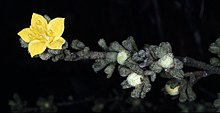Asterolasia phebalioides
Asterolasia phebalioides, commonly known as downy starbush,[2] is a species of shrub in the family Rutaceae and is endemic to south-eastern continental Australia. It has densely crowded heart-shaped to wedge-shaped leaves densely covered with star-shaped hairs, and single yellow flowers borne on the ends of branchlets with star-shaped hairs on the back of the petals.
| Downy starbush | |
|---|---|
 | |
| Asterolasia phebalioides in the ANBG | |
| Scientific classification | |
| Kingdom: | Plantae |
| Clade: | Tracheophytes |
| Clade: | Angiosperms |
| Clade: | Eudicots |
| Clade: | Rosids |
| Order: | Sapindales |
| Family: | Rutaceae |
| Genus: | Asterolasia |
| Species: | A. phebalioides |
| Binomial name | |
| Asterolasia phebalioides | |
| Synonyms[1] | |

Description
Asterolasia phebalioides is a shrub that typically grows to a height of 50 cm (20 in) and is more or less covered with woolly, grey hairs and silvery to rust-coloured star-shaped hairs. The leaves are densely crowded on short branches, wedge-shaped to heart-shaped, 5–7 mm (0.20–0.28 in) long and densely covered with star-shaped hairs. The flowers are borne singly on the ends of branchlets with five scaly bracts at the base. The petals are yellow, broadly elliptical, 6–10 mm (0.24–0.39 in) long and covered with star-shaped hairs on the back. Flowering occurs from September to December.[2][3][4][5]
Taxonomy
Asterolasia phebalioides was first formally described in 1854 by Ferdinand von Mueller and the description was published in Transactions of the Philosophical Society of Victoria.[6][7]
Distribution and habitat
Downy starbush grows in woodland, forest and heath and occurs in the Grampians and Little Desert regions of Victoria and on Kangaroo Island in South Australia.[2][3]
Conservation status
Asterolasia phebalioides is listed as "vulnerable" under the Australian Government Environment Protection and Biodiversity Conservation Act 1999 and a recovery plan has been prepared. The main threats to the species include vegetation clearance, weed invasion and disease caused by the fungus Phytophthora cinnamomi.[5][8]
References
- "Asterolasia phebalioides". Australian Plant Census. Retrieved 29 June 2020.
- Wilson, Paul G. "Asterolasia phebalioides F.Muell". Australian Biological Resources Study, Department of Agriculture, Water and the Environment, Canberra. Retrieved 29 June 2020.
- Duretto, Marco F. "Asterolasia phebalioides". Royal Botanic Gardens Victoria. Retrieved 29 June 2020.
- "Asterolasia phebalioides". State Herbarium of South Australia. Retrieved 29 June 2020.
- Carter, Oberon. "National Recovery Plan for the Downy Star-bush Asterolasia phebalioides" (PDF). Australian Government Department of the Environment. Retrieved 29 June 2020.
- "Asterolasia phebalioides". APNI. Retrieved 29 June 2020.
- von Mueller, Ferdinand (1854). "Definitions of rare or hitherto undescribed Australian plants, chiefly collected within the boundaries of the colony of Victoria". Transactions of the Philosophical Society of Victoria. 1: 10. Retrieved 29 June 2020.
- "SPRAT Profile Asterolasia phebalioides - downy star-bush". Australian Government Department of Agriculture, Water and the Environment. Retrieved 29 June 2020.
